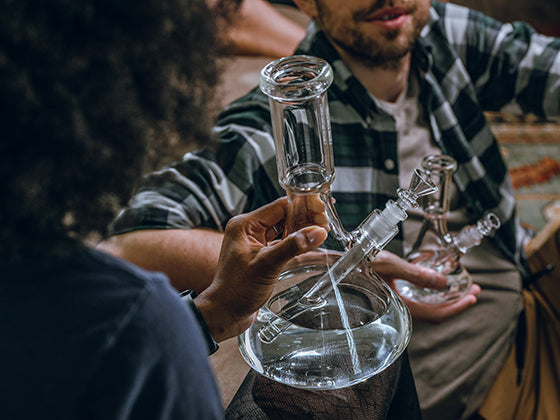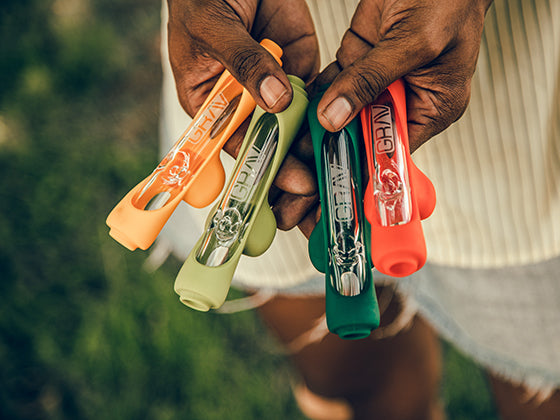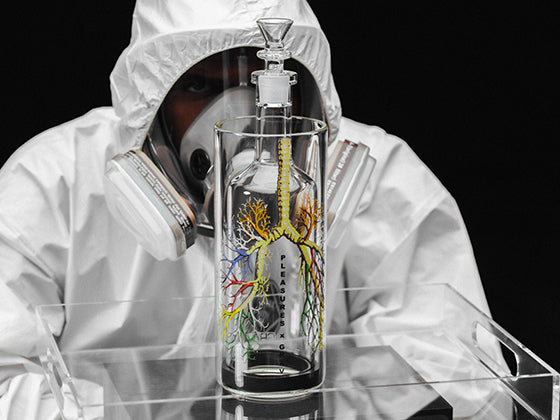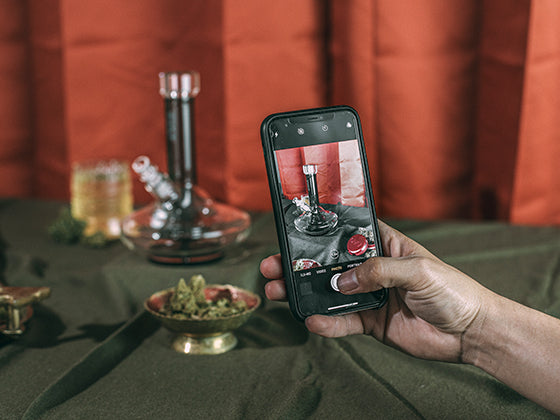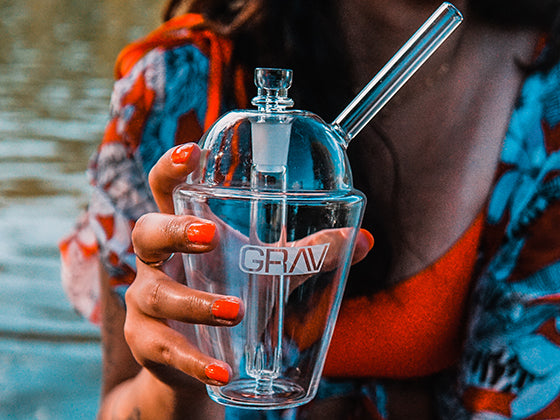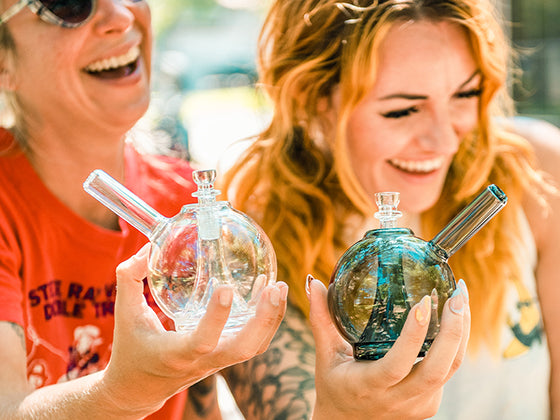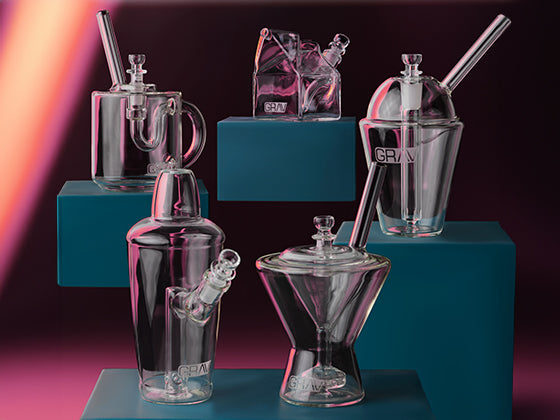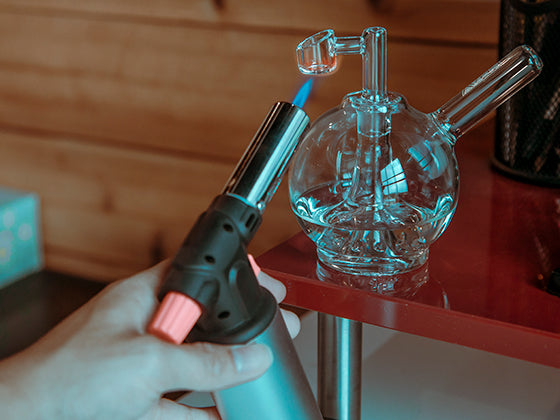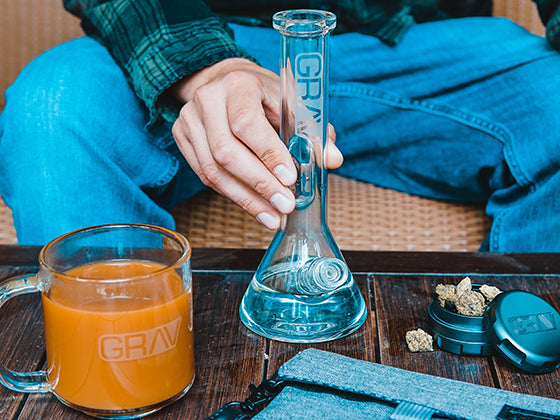1) Cleaning Glass with Alcohol Solution:
If you’d like to make your own pipe-cleaning solution from scratch, you’ll need salt and rubbing alcohol. A small bottle of isopropyl alcohol and coarse, kosher salt (used to brine) work best, and both should be available at your local grocery store. Mix equal parts of the alcohol and salt in a bowl or tupperware large enough to fit the piece you’d like to clean. Depending on the strength of the solution, it may be powerful enough to fade the label on the outside of your pipe. To protect your label, simply cover it with a strip of blue painter’s tape. Remove the tape when you’ve finished cleaning and rinsing your pipe. Let the piece soak in the saline mixture for anywhere between 1 hour and 1 day. The longer it soaks, the easier it will be to break up any tar and resin. Take the soaked pipe and fill it halfway with the solution using a funnel or measuring cup. If you’re cleaning a water pipe, consider blocking any joints with a GRAV® cleaning plug, available in 14mm and 19mm. If you’re cleaning a bubbler or hand pipe, simply block the necessary openings with your fingers. Shake the pipe vigorously but carefully. It’s best not to shake too close to any hard surfaces in order to avoid accidentally hitting the pipe against something and breaking it in your hand. Also, just in case your fingers slip and solution leaks out, you may want to avoid shaking near any fabrics or items that could be stained. As you shake the pipe, the solution should break up the tar and expose clean glass. Shake for 3 minutes, then empty the pipe down your kitchen sink while running hot water. You may need to refill the pipe and shake again multiple times until the piece is satisfactorily clean. If you find a particular spot is not getting clean, use a Q-Tip or pipe cleaner soaked in the solution to reach the spot and scrub it manually. When you’ve finished cleaning, rinse the pipe, first with hot water to remove any layer of remaining solution and then cold water to prevent the piece from fogging. Let it dry before using it again.
2) Cleaning Glass with Soaker:
Soaking your pipe in a cleaning solution is the simplest and most thorough cleaning method. There are several pipe cleaning solutions on the market. The most important aspect to consider is whether the solution could leave behind any chemical residue that would be harmful if smoked. We recommend Grunge Off, both for safety and efficacy. Grunge Off is citric acid-based and can be found at most head shops and several online retailers. Whichever cleaning solution you decide to use, just make sure it’s intended for use with glass pipes or stemware. Depending on the strength of the solution, it may be powerful enough to fade the label on the outside of your pipe. To protect your label, simply cover it with a strip of blue painter’s tape. Remove the tape when you’ve finished cleaning and rinsing your pipe. If you’re cleaning a hand pipe or bubbler, find a container that will fit your piece. Place your pipe in the container and fill it with your chosen cleaning solution. Submerge the piece entirely and rotate it to allow any air bubbles to escape. Let the pipe soak anywhere between one hour and one day. The longer it soaks, the more tar will be dissolved and removed from your piece. Once you’ve finished soaking it, rinse your pipe over your kitchen sink with hot water. Most of the tar should have broken up and will be washed away. If there are any troublesome spots remaining, use a Q-Tip or pipe cleaner soaked in solution to scrub it manually. Rinse the piece again with cold water and let it dry before using it again. The same process applies to water pipes, except instead of filling a container with solution, simply fill the pipe itself. Block the pipe’s ground joint with a GRAV® Cleaning Plug available in 14mm and 19mm, and use a funnel to fill it with solution.
3) Cleaning Glass with Shaker:
A shaker solution is the fastest way to clean your pipe. Fill your pipe a little more than halfway with the solution and seal off all openings. Joints can be sealed using GRAV® cleaning plugs, available in 14mm and 19mm. You can cover smaller openings, like mouthpieces and carbs, with your fingers. Shake the pipe vigorously but carefully. It’s best not to shake too close to any hard surfaces in order to avoid accidentally hitting the pipe against something and breaking it in your hand. Also, just in case your fingers slip and solution leaks out, you may want to avoid shaking near any fabrics or items that could be stained. As you shake the pipe, the solution should break up the tar and expose clean glass. Shake for 3 minutes, then empty the pipe down your kitchen sink while running hot water. You may need to refill the pipe and shake again multiple times until the piece is satisfactorily clean. If you find a particular spot is not getting clean, use a Q-Tip or pipe cleaner soaked in the solution to reach the spot and scrub it manually. When you’ve finished cleaning, rinse the pipe, first with hot water to remove any layer of remaining solution and then cold water to prevent the piece from fogging. Let it dry before using it again.
4) Cleaning Grinders:
The most important thing to remember when cleaning your GRAV® Grinder is that certain components should never get wet. Ideally, the only pieces to wash are the lid and the bottom row of teeth. You can scrub the teeth under hot water using a spare toothbrush or other firm-bristled brush. Dry these components thoroughly before reassembling your grinder or your whole life will just be clogs. The central chamber can be separated from the assembly and wiped clean using a damp cloth or paper towel. The magnetic kief screen can be gently cleaned with a spare toothbrush or other firm-bristled brush. The bottom-most component - the kief compartment - should never be cleaned. Its purpose is to store the kief that accumulates from grinding plant matter, and it should only be emptied using the curved GRAV® Scraper included with the grinder.
5) Cleaning the Fire-Button™:
The original Fire-Button skillet was removable, but not designed to be disassembled for cleaning. If you have this single-piece skillet, you can clean it using a Q-Tip. Heat the skillet until red hot, then let it cool to a point that the plant extract is still soft but no longer smoking. Gently clean the surface of the skillet with the Q-Tip until it’s free of excess material.
The current Fire-Button skillet can be disassembled for easy cleaning. Each pack of replacement skillets comes with one titanium housing assembly and five ceramic skillet cores. Unscrew the lid of the titanium housing to access the skillet core. Remove the core and wipe it on all sides with the end of a Q-Tip to remove excess material. Also clean out the inside of the titanium housing before reassembling the skillet. Regardless of what version of skillet you have, we recommend regular users replace their Fire-Button skillet every 30 days. Replacement skillets are available for purchase here!

